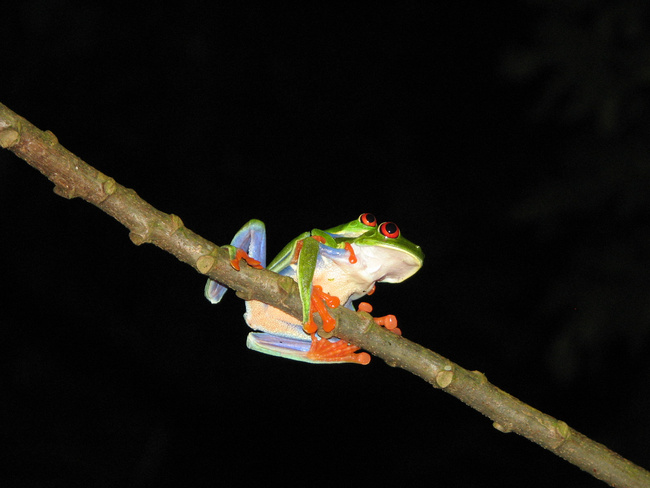Red-Eyed Leaf (Tree) Frog
Red-Eyed Leaf (Tree) Frog (Agalychnis callidryas)Spahish Name: Rana Ojos Rojos

More about Red Eyed Tree Frog
Habitat and Range
Treetops conceal this bright species in lowland moist and wet forests, in some premontane wet forest and rainforest, and in disturbed habitats and mangroves. The frog can be found as high as 1,200 m, but tends to stay at low elevations.
The Leaf Frog lives from Mexico to eastern Panama.
Physical Description
The namesake huge red eyes, long, narrow body, and distinct coloration make this tree frog stand out among other species. The frog’s back is a bright green to help it blend into the treetops when the frog is sitting still. When it moves, it exposes bright orange hands and feet that have large, sticky finger disks, and dark blue thighs with white or cream vertical bars. When the frog sleeps, it rests on its white belly, keeping its bright hands and thighs folded out of sight. When the frog is startled, the flashes of bright color confuse its attacker as the frog escapes.
Biology and Natural History
The striking Red-Eyed Leaf (or Red-Eyed Tree) Frog has become a widely photographed and recognized amphibian in Central America.
In the forest this frog hides among branches during the day and dry times. It is more active during the rainy season, making trips to breeding ponds at night. Instead of hopping or walking like frogs that spend a lot of time on the ground, this frog climbs hand over hand through the trees. The adhesive disks on its toes and fingers help the frog cling to surfaces that are entirely vertical; this species also has a toe joint that keeps the toe disk flat on a surface no matter how the frog positions its feet. This frog can even parachute, by spreading out its gangly limbs and large feet and dropping from higher perches to lower branches.
On nights in the early rainy season, the tree frogs descend to breed. Males call “chock” as they move from perch to perch, waiting for a female to approach. When she does, the male climbs onto her back in the amplexus position and she begins to carry him around as they look for a site for their eggs. Males sometimes compete for a female, or a latecomer tries to remove a male already on the female’s back. A second male may even mount the female next to the first male (females are quite a bit larger than males) and share in fertilization as the female deposits the eggs. Before laying the eggs, she carries her mate(s) to water, fills her bladder, and then deposits the eggs where they will stay until they hatch, usually on the surface of a leaf hanging over water. She lays 20-50 eggs, the male fertilizes them, and then the female empties her bladder full of water on the eggs to keep them moist. The mating pair may repeat this process for up to 5 clutches of eggs that night. The female will lay eggs on two nights each breeding season.
When the tadpoles are ready to hatch, they wiggle free of the eggs and drop into the water below. Before they hatch, they may perish from drying out, predation, or slipping off the leaf too early. Bats, birds, and snakes may eat the adults despite the weak toxins in their skin.
Diet
The Red-Eyed Tree Frog feeds on moths, crickets, and other insects that are active at night.
Height/Weight
Adult females, at 51-71 mm, can be nearly twice the size of males, which are 30-59 mm.
Taxonomy
Order: Anura
Family: Hylidae
Source
Henderson, Carrol L. Field Guide to the Wildlife of Costa Rica. University of Texas Press, Austin, 2002.
Leenders, Twan. A Guide to Amphibians and Reptiles of Costa Rica. Zona Tropical, S.A, Miami, FL, 2001.
Savage, Jay M. The Amphibians and Reptiles of Costa Rica: A Herpetofauna between two Continents, between Two Seas. The University of Chicago Press, Chicago, 2002.
Amy Strieter, Wildlife Writer
Red Eyed Tree Frog Sightings
Similar Profiles
It's more than just having a good time or visiting beautiful places (although that's absolutely a part of it!), it's about being part of a unique experience that stays with you.



